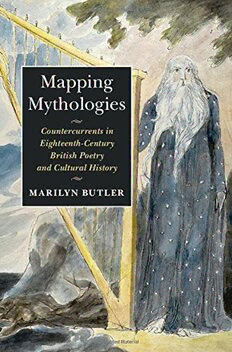
Mapping mythologies : countercurrents in eighteenth-century poetry and cultural history PDF
Preview Mapping mythologies : countercurrents in eighteenth-century poetry and cultural history
MAPPING MYTHOLOGIES Inthisground-breakingworkofrevisionaryliteraryhistory,Marilyn Butler traces the imagining of alternative versions of the nation in eighteenth-century Britain, both in the works of a series of well-known poets (Akenside, Thomson, Gray, Collins, Chatterton, Macpherson, Blake) and in the differing accounts of the national culture offered by eighteenth-century antiquarians and literary historians. She charts the beginnings in eighteenth-century Britain of what is now called cultural history, exploring how and why it developed, and the issues at stake. Her interest is not simply in a succession of great writers, but in the politics of a wider culture, in whichwriters,scholars,publishers,editors,booksellersandreadersall play their parts. For more than thirty years, Marilyn Butler was a toweringpresenceineighteenth-centuryandRomanticstudies,and thismajorworkispublishedforthefirsttime. marilyn butler (1937–2014) was a prominent scholar in eighteenth-century and Romantic studies, a ground-breaking practi- tioner and theorist of the historicist criticism of literary texts, and pioneering scholarly editor of hitherto marginalised women writers. HerwidelyacclaimedpublicationsincludeMariaEdgeworth:ALiterary Biography (1972); Jane Austen and the War of Ideas (1975); Peacock Displayed: A Satirist in his Context (1979); Romantics, Rebels and Reactionaries: English Literature and its Background 1760–1830 (1981); andseminalscholarlyeditionsofworksbyMaryWollstonecraft,Maria Edgeworth,MaryShelleyandJaneAusten.ShewasKingEdwardVII Professor of English Literature at the University of Cambridge from 1986to1993andRectorofExeterCollege,Oxford,from1993to2004. MappingMythologies,finishedin1984,butneverhithertopublished,is thefirstvolumeofanever-completedlargerprojectonliterarymythol- ogiesbetween1730and1830. MAPPING MYTHOLOGIES Countercurrents in Eighteenth-Century Poetry and Cultural History MARILYN BUTLER UniversityPrintingHouse,Cambridgecb28bs,UnitedKingdom CambridgeUniversityPressispartoftheUniversityofCambridge. ItfurtherstheUniversity’smissionbydisseminatingknowledgeinthepursuitof education,learningandresearchatthehighestinternationallevelsofexcellence. www.cambridge.org Informationonthistitle:www.cambridge.org/9781107116382 ©MarilynButler2015 Thispublicationisincopyright.Subjecttostatutoryexception andtotheprovisionsofrelevantcollectivelicensingagreements, noreproductionofanypartmaytakeplacewithoutthewritten permissionofCambridgeUniversityPress. Firstpublished2015 PrintedintheUnitedKingdombyClays,StIvesplc AcataloguerecordforthispublicationisavailablefromtheBritishLibrary LibraryofCongressCataloguinginPublicationdata Butler,Marilyn. Mappingmythologies:countercurrentsineighteenth-centuryBritishpoetry andculturalhistory/byMarilynButler;prefacebyHeatherGlen. pages cm Includesbibliographicreferencesandindes. isbn978-1-107-11638-2(hardback) 1. Englishpoetry–18thcentury–Historyandcriticism. 2. Mythinliterature. 3. Literatureandsociety–GreatBritain–History–18thcentury. 4. Literature andmyth–GreatBritain.I.Title. pr555.m93b88 2015 821′.50937–dc23 2015008919 isbn978-1-107-11638-2Hardback CambridgeUniversityPresshasnoresponsibilityforthepersistenceoraccuracyof URLsforexternalorthird-partyinternetwebsitesreferredtointhispublication, anddoesnotguaranteethatanycontentonsuchwebsitesis,orwillremain, accurateorappropriate. Contents Preface pagevii byHeatherGlen 1 Amapofmythologising 1 2 ThomsonandAkenside 21 3 CollinsandGray 56 4 Theforgers:MacphersonandChatterton 88 5 PopularAntiquities 123 6 Blake 162 Coda 189 Notes 193 Index 209 v Preface For more than thirty years, from the 1970s to the early 2000s, Marilyn Butler was a powerful presence in eighteenth-century and Romantic literary studies on both sides of the Atlantic, intellectually energising, generouslyenabling,imaginativelyreconfiguringthefieldsonwhichshe worked. When she was prevented by illness from continuing with her work,herhusbandandfriendstogethersortedherpaperstobedeposited in the Bodleian Library. Amongst them, unexpectedly, we found the typescript of a book that had been completed in 1984. There were chapters on Macpherson and Chatterton, but also on Akenside and Thomson, and Gray and Collins (not subjects on which Butler had published);therewasalsoalongchapteronEnglishandWelshpopular antiquarianism. And there was an introductory chapter, in which, with characteristic boldness, Butler set out the agenda for a new kind of history of later eighteenth-century poetry. On top of the typescript, there was a letter from the late Kim Scott Walwyn, then literary editor atOxfordUniversityPress,urgingButlertoprepareitforpublicationas the firstvolume of a larger work. Upuntil1984,ButlerhadpublishedmainlyonauthorsoftheRomantic period – Maria Edgeworth, Jane Austen, Thomas Love Peacock, the writers she called Romantics, Rebels and Reactionaries; she was about to produce an anthology of writings relating to the French Revolution con- troversy.Butfrom1980onwardithadbeenevidentthatshewasworking on an ambitious project that had its beginnings in her understanding of anearlierperiod.Partsofthisworkappearedthroughthe1980sand1990s as conference papers and published articles, rather like the mountain peaks of a submerged continent: mostly on later Romantic subjects, they had titles such as ‘Nymphs and Nympholepsy: the Visionary Woman and the Romantic Poet’ (1985), ‘The Orientalism of Byron’s Giaour’ (1988), ‘Romantic Manichaeism: Shelley’s “On the Devil” and Byron’sMythologicalDramas’(1989),‘ShelleyandtheEmpireintheEast’ vii viii Preface (1996).1Therewereplansforatwo-partbookon‘PoetsandMyths’among Butler’spapers,andagreatdealofmaterialforthelatterpart.Thatbookas sheconceiveditwasnevertobecompleted:sheseemstohavefoundwork onthe secondvolume socompelling that shecould not sparethe timeto putthefinaltouchestothefirst.But,asKimScottWalwynsaw,thatfirst volumecouldstandalone.Here,inracyoutline,wehavethebold,original thinking that underpinned Butler’s projected magnum opus on literary mythologiesinthewritingofthelongeighteenthcentury. Butler finished Mapping Mythologies three years after her Romantics, RebelsandReactionarieshadbeenhailedbyreviewersasa‘ground-breaking’ 2 newkindofliteraryhistory. This,hernextbook,waswrittenattheheight ofherpowers.LikeRomantics,RebelsandReactionaries,itbringstogethera numberofdiverseauthorsandgenres,bothcanonicalanduncanonical;like thatearlierwork,itdoesnotpresentdetailedscholarshiporextensiveclose readings,butoffersasometimespolemicalviewofalargerliteraryfield.The writerswhomButlertakesashersubjectsare,shesays,alldistinguishedby theirinterestin‘non-Christianmythologies–storiesfromancienttimesand oftenfromforeignparts,whichconveythesocialandreligiouspracticesand beliefsofanalien society’ (p. 17).But this, itquicklybecomesclear,isnot tobeaconventionalliteraryhistoryofthekindthattracesa‘theme’inthe literatureofaperiod;norisittobeastudyofuniversalandtranshistorical patterns of symbolism. To Butler, that interest in mythology, differently inflected in the work of each of the writers she considers, is not simply expressiveof‘animpulsetoreligionwithinthecollectiveunconscious’(p.5); indeed, she argues, it ‘cannot indeed be taken as face-value evidence of an interestinreligionassuchatall’(p.3).Andherownconcernwithmythol- ogyisnotsimplyaninterestinesotericreligiousnarratives. Butler’s opening remarks indicate thecontext within which she herself waswriting,andsetoutthegroundsofherdifferencefromtheestablished scholarsinthefield.‘Myth’wasatermthatdominatedRomanticstudies, especiallyinNorthAmerica,forthirtyyearsormoreaftertheendofWorld WarII.NorthropFrye’sgrandtheorisingoftheconnectionsbetweenthe formal principles of art and the structures of primitive myth focused centrally on the mythopoeic poetry of the Romantics.3 Harold Bloom’s study of Romantic myth-making, The Visionary Company (1970), was to prove hugely influential, as were M.H. Abrams’ exploration of Romantic myths of apocalypse in Natural Supernaturalism (1971) and Geoffrey Hartman’s view of ‘the Romantic period’ as ‘a time when art frees itself from its subordination to religion or religiously inspired myth and continues or even replaces them’.4 Butler’s summary sketches of the
